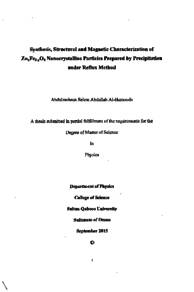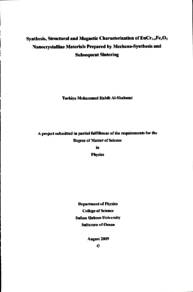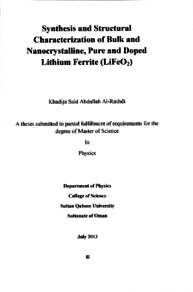Document
Synthesis, structural and magnetic characterization of ZnxFe3-yO4 nanocrystalline particles prepared by precipitation under reflux method
Publisher
Sultan Qaboos University
Gregorian
2015
Language
English
Subject
English abstract
Nanocrystalline ZnxFez-yO4 (y = 2x/3) samples were prepared using the precipitation under reflux method and investigated both structurally and magnetically. TEM reveals the particles to have almost spherical shape with radii ranging between 10 to 40 nm. Rietveld refinement of the XRD data and Mössbauer spectroscopy have shown the sample with x = 0.00 to be composed of magnetite and maghemite in the ratio of ~4:1 respectively. Doping with Zn2+ ions was found to inhibit the magnetite-to-maghemite transformation. This was related to the possible presence of the dopant Zn2+ ions entirely on the shells of the nanoparticles to prevent the oxidization of the Fe2+ ions at the interior core of the magnetite nanoparticles. XRD and Mössbauer spectroscopy have consistentlyshown that the Zn2+ ions exclusively occupy the tetrahedral A-sites in the spinel-related structure.
The Mössbauer quadrupole shifts indicate that the cubic symmetry remains
almost unchanged at the 57Fe nuclear site upon Zn2+ doping. The Mössbauer hyperfine
magnetic fields at both spinel crystallographic sites decrease with increasing x suggesting
weaker magnetic super-exchange interactions as the more of the diamagnetic Zn2+ ions
are incorporated in the material. More ZnyFe3-y04 particles tend to be superparamagnetic
as x value increases, with blocking temperature > 80 K. In consistency with Néel's model
of ferrimagnetism, the substitution of Zn2+ at the tetrahedral sites was found to increase
the saturation magnetization with increasing x up to x = 0.30 where a value similar to that
of bulk magnetite was attained. The decrease in the saturation magnetization for the
samples with x = 0.40 and 0.50, was explained in terms of spin canting. The coercivity
decreased with increasing the Zn2+ content in in the ZnxFez-yO4 samples.
Member of
Resource URL
Arabic abstract
تم تحضير عينات و0-ZnFes النانوبلورية (3/ y = 2x ) بطريقة الترسيب وكذلك تم التحقق من التركيب الهيكلي والمغناطيسي. تقنية مجهر النفاذ الالكتروني (TEM) تكشف عن جسيمات قريبة للشكل كروي يتراوح نصف قطرها بين 10 و 40 نانومتر. باستخدام طريقة ريتفيلد لتحليل أنماط حيود الأشعة السينية (Rietyeld) واطياف المسباور (Massbauer) تبين وجود اكاسيد الحديد المغناطيسية الماجنيتايت (Fe3O4) والماجمايت ( y- Fe2O3) في العينات عندما تكون 0. 00 = x بنسبة 4 إلى 1 بالتتالي. لوحظ ان التشويب بأيونات الزنك (Zn21) يحول من تحول الماجنيتایت الى الماجمايت. السبب المحتمل لذلك ربما يعزي لوجود أيونات Zn2 على سطح الجسيمات النانوبلورية مما يمنع من تأكسد أيونات الحديد الثنائي +Fe2 المتواجد في داخل الجسيمات النانوبلورية أيونات الحديد الثلاثي Fe3. أنماط حيود الأشعة السينية واطياف المسباور تشيران إلى أن أيونات Zn2 تحتل حصريا المواقع-A رباعية الأوجة في التركيب الهيكلي الشبيه بمركب الاسبيل. قيم معاملات إنقسام تحول رباعي الأقطاب الكهربي (quadrupole splitting / shifting ) في اطياف المسباور لنواة Fe اشارت الى ان التماثل المكعبي لم يتغير عند التشويب بأيونات **Zn غير المغناطيسية. قيم الحقول المغناطيسية متناهية الدقة لاطياف المسباور hyperfine) (magnetic fields لتويات +Fe3 في المواقع المختلفة داخل البلورات تتناقص بزيادة قيمة (x) مما يدل على ضعف التبادل المغناطيسي عندما يزداد عدد أيونات **Zn غير المغناطيسية في المادة. المزيد من جسيمات , ZnxFe3 -yO4 تميل إلى أن تكون سوبربرامغاطيسية (superparamagnetic) بزيادة قيمة (x) ولها درجات حرارة للااتقال المغناطيسي > K 80. بالتوافق مع نموذج نبيل (Neel) للفيريمغناطيسية، وجد ان احتلال أيونات +Zn2 في المواقع۔ -A رباعية الاوجة بدلا عن +Fe3 يزيد من التشبع المغناطيسي مع زيادة قيمة x الى 0. 30 حيث تصبح القيمة قريبة من قيمة التشبع المغناطيسي للجسميات الكبيرة للماجنيتايت. الانخفاض لمقدار التشبع المغناطيسي عندما تكون قيمة 0.04=x و x = 0 . 50 يمكن تفسيره بوجود میلان (canting) للعزم المغناطيسي.
Category
Theses and Dissertations



